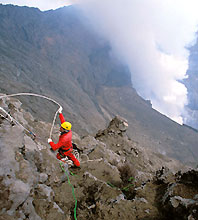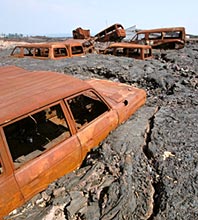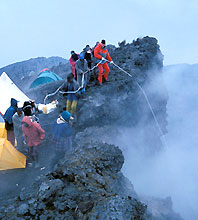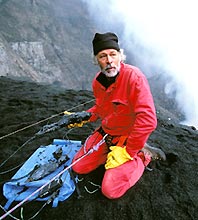|
The production of a documentary film is never simple, but I seem inevitably
drawn to subjects that pose particularly difficult challenges. On past
projects, I have ventured with scientists and camera crews through dense rain
forests, rappelled deep into limestone caves, and explored a lake filled with
dissolved toxic gas. Yet my journey into the crater of the volcano Nyiragongo
was undoubtedly one of the most complicated and
dangerous productions of my life.
We faced threats long before we even reached the volcano. Nyiragongo is located in
one of the world's most unstable, war-torn countries. Though called the
Democratic Republic of Congo, it's hardly a working democracy. The region
around the volcano, including the crowded city of Goma, lies on the border
between Congo and Rwanda. Armed bandits crisscross the troubled region. These
thugs live by plundering, and they don't hesitate to kill. We knew that our
film crew possessed many items of great interest to them, including a
generator, solar panels, and walkie-talkies.
One night we had a frightening near-encounter with some of these bandits. We
were in a village outside of Goma when we heard shots being fired. Jacques
Durieux, the scientist leading the expedition, was very nervous. I didn't know
it at the time, but he was carrying a large sum of cash in order to pay the
local handlers helping with the production. We heard warnings on the radio that
the bandits were coming our way, and soon a military escort arrived to take us
back to Goma. We learned that a group of bandits had attacked the neighboring
village and that two of the assailants had been killed. After the incident, the
United Nations asked us not to leave Goma after nightfall for the rest of our
stay.
 Up and into the volcano
Up and into the volcano

Once we reached the volcano, there seemed, at first, relatively little to
fear—after all, armed escorts were watching over us. But we soon learned
how unfriendly this environment was, and how this would complicate an already
daunting film shoot.
After climbing to the 11,400-foot summit, we set up our base camp at the
crater's edge. There were no flat areas on the steep slope, so we had to
flatten the ground and lay down small platforms on which we could pitch our
tents. We anchored ourselves in for the night and hoped all of our equipment
would be secure despite the high winds.
The scientists would be working primarily on a rocky plateau deep within the
crater. Rather than shuttle back and forth to the base camp, which would take
hours each day, we set up another camp directly on the plateau. Filming in an
environment as hostile as a volcano demands not just a great deal of
preparation but also a lot of equipment. To facilitate the transport of the
scientific materials, film gear, food, and other supplies, we installed what
essentially amounts to an elevator between the edge of the crater and the spot
where we were working. It was nearly 1,000 feet high! This elevator saved us
precious time.
 Shaky ground
Shaky ground

Contrary to what you might think, the risk of being surprised by an eruption
and streams of lava while you are inside a volcano is practically zero. There
are almost always warning signs of such activity, and we were with scientists
who know Nyiragongo well. The main threat to this expedition was the unstable
walls of the volcano, which could collapse at any time. We could never trust
the ground we were walking on.
The ring-shaped plateau on which we were working—and camping—was
riddled with fractures, and the jagged rim clearly showed where huge parts of
the plateau had broken off and plummeted to the lava lake below. While we were
in the crater, we witnessed collapsing rock and mud slides several times a day.
But to do the sampling, we had to be in this precise location at the edge of
the plateau.

By the time the sampling was completed, we had spent nearly two weeks
living inside the crater.

We all had harnesses, and the rope to which we were fastened was tied to a spot
many yards from the edge. Luckily there were no rock slides or collapses while
we were at the edge sampling and filming, but I shudder to think what would
have happened if there had been. Would the anchor and rope have held if six
people had fallen simultaneously?
 Roughing it
Roughing it

The living conditions inside the volcano were also very difficult. We had the
resources to cook only the simplest meals. We had brought only a small hot
plate to reheat water, and we ate dried food. This was quite bearable, but the
air quality in the volcano was not. When there wasn't any wind, the volcano's
gas plume and cinders rose straight up from the lava lake skyward, and the air
around us on the plateau was relatively clear. But when the wind picked up, the
environment would change completely in a matter of minutes. Acidic gases would
blow over the plateau. We could barely see in front of us, and what the
researchers called "hairs of Pelée" swirled around us. These are fine
needles of solidified lava. Sometimes they pierce the skin and break,
making them very difficult to extract. We often had to protect our eyes with
safety glasses.
The air would become so unbreathable at times that the film crew had to put on
gas masks. In the film, we rarely see the researchers with a mask, but that's
mostly because they had become used to the gas. In my opinion, they were making
a mistake. Whether they're used to it or not, the gas still attacks the
respiratory system.

I for one am attracted by intense sensations and sometimes even by
danger.

By day, a gas mask is not too hard to wear, but things get tricky at night.
While we were asleep, as soon as we started sweating, the plastic mask would
stick to our skin. We often had to remove the masks to dry our faces. We
couldn't sleep well like this. After a few days in these conditions, the whole
crew was exhausted. Yet both filmmakers and scientists pushed on. By the time
the sampling was completed, we had spent nearly two weeks living inside the
crater.
 Why make the effort
Why make the effort

They aren't easy, but expeditions of this scope are necessary to better
understand volcanoes, and it's critical that scientists know this particular
volcano as well as possible. Because of its proximity to Goma, with its 500,000
inhabitants, an eruption at Nyiragongo could be catastrophic. All information
gathered by Durieux and his colleagues could help fill in a picture of what is
happening at the volcano.
Some scientists argue that it is not necessary to sample lava
directly at the bottom of the crater. But I think these critics are forgetting
one aspect of this effort: basic research. In my mind—and this is just my
personal opinion—asserting that a sample from the lake of lava won't
bring new information ignores the possibility of making new discoveries.
Scientific discoveries don't always correspond to what we already know, and
it's often by detecting abnormalities that scientific research makes advances.
Even if the analysis of the lava samples shows nothing strikingly new, it may
later help to prove something we never suspected to be true.
More and more, robotic technology and computer simulations allow researchers to
avoid taking life-threatening risks to advance scientific knowledge. One day
scientists may be able to take samples from volcanoes and other hostile places
without even leaving their labs. That day may not be far off, and that's
certainly a good thing. But I for one am attracted by the chance to explore new
environments, by intense sensations, and sometimes even by danger. In short, I
am drawn to what we call adventure. In this sense, even if it isn't rational, I
hope that day never arrives.


| 

Volcanologist Jacques Durieux makes a near 1,000-foot descent from the
crater's edge to a ring-shaped plateau within Nyiragongo.

| |

The 2002 eruption of Nyiragongo unleashed a flood of scorching lava that
caught the city of Goma by surprise. More than 100 people died and 120,000 were left
homeless.

| |

The expedition's base camp, perched precariously on the fragile rim of the
crater.

| |

An exhausted but pleased Durieux holds his hard-won sample of cooled,
solidified lava.

| |
|

